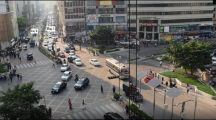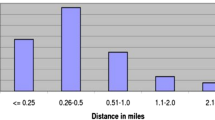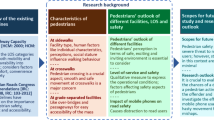Abstract
An uncontrolled intersection increases the possibility of road user disputes between pedestrians and vehicles crossing the road concurrently. Conflicts would erupt if their motions stayed unchanged. When there is a dispute, pedestrians or drivers will change their activities to avoid an accident, which is known as the conflict yielding Behaviour of pedestrians or drivers. Pedestrians’ conflict yielding attitudes significantly impact traffic safety at intersection crossings. This research investigates the factors that influence pedestrians’ conflict yielding Behaviour at uncontrolled T-intersections. These factors may be classified into two categories: vehicle characteristics and pedestrian characteristics. A multinomial logistic regression was performed on the pedestrian conflict yielding Behaviour data concerning various influencing factors to check out the most significant factors. Five out of eight criteria affect pedestrian conflict yielding behaviour viz; conflicting vehicle, the distance between conflicting vehicles and crossing pedestrians, vehicles’ conflicting Behaviour, the number of crossing pedestrians in a single time frame, and pedestrian age. The findings also demonstrated that pedestrian conflict yielding Behaviour is characterized by waiting, decelerating, and maintaining a constant pace. Acceleration and path-changing Behaviours are quite unusual. The findings imply that if the distance between the conflicting vehicle and the conflicting pedestrian is large or medium, pedestrians choose to maintain or accelerate their speed rather than wait. When the distance is short, however, pedestrians choose to wait.



Similar content being viewed by others
References
B.R. Kadali, P. Vedagiri, Effect of vehicular lanes on pedestrian gap acceptance behaviour. Procedia Soc. Behav. Sci. 104, 678–687 (2013). https://doi.org/10.1016/j.sbspro.2013.11.162
B.R. Kadali, P. Vedagiri, Modelling pedestrian road crossing behaviour under mixed traffic condition. Eur. Transp. Trasp. Eur. 55(3), 1–7 (2013)
D.S. Pawar, G.R. Patil, Pedestrian temporal and spatial gap acceptance at mid-block street crossing in developing world. J. Safety Res. 52, 39–46 (2015). https://doi.org/10.1016/j.jsr.2014.12.006
M.S. Serag, Modelling pedestrian road crossing at uncontrolled mid-block locations in developing countries. Int. J. Civ. Struct. Eng. 4, 274–285 (2014). https://doi.org/10.6088/ijcser.201304010027
K. Suzuki, H. Ito, Empirical analysis on risky behaviours and pedestrian-vehicle conflicts at large-size signalized intersections. Transp. Res. Procedia 25, 2139–2152 (2017). https://doi.org/10.1016/j.trpro.2017.05.411
E. Papadimitriou, S. Lassarre, G. Yannis, Pedestrian risk taking while road crossing: a comparison of observed and declared behaviour. Transp. Res. Procedia. 14, 4354–4363 (2016). https://doi.org/10.1016/j.trpro.2016.05.357
T. Ding, S. Wang, J. Xi et al., Psychology-based research on unsafe behaviour by pedestrians when crossing the street. Adv. Mech. Eng. (2015). https://doi.org/10.1155/2014/203867
Zheng Y, Analysis of factors influencing pedestrian injury severity in pedestrian-vehicle crashes. in T&DI congress 2014: planes, trains, and automobiles, pp. 448–457. (2014). https://doi.org/10.1061/9780784413586.043
V. Cantillo, J. Arellana, M. Rolong, Modelling pedestrian crossing behaviour in urban roads: a latent variable approach. Transp. Res. Part F Traffic Psychol. Behav. 32, 56–67 (2015). https://doi.org/10.1016/j.trf.2015.04.008
R. Almodfer, S. Xiong, X. Kong, P. Duan, Pedestrian crossing speed patterns and running frequency analysis at a non-signalized marked crosswalk: quantitative and qualitative approaches. Sustain. Cities Soc. 34, 183–192 (2017). https://doi.org/10.1016/j.scs.2017.07.003
J. Shi, Y. Chen, F. Ren, J. Rong, Research on pedestrian behaviour and traffic characteristics at unsignalized midblock crosswalk: case study in Beijing. Transp. Res. Rec. (2007). https://doi.org/10.3141/2038-04
W.K.M. Alhajyaseen, M. Iryo-Asano, Studying critical pedestrian behavioural changes for the safety assessment at signalized crosswalks. Saf Sci 91, 351–360 (2017). https://doi.org/10.1016/j.ssci.2016.09.002
N.N. Ferenchak, Pedestrian age and gender in relation to crossing behaviour at midblock crossings in India. J. Traffic Transp. Eng. 3, 345–351 (2016). https://doi.org/10.1016/j.jtte.2015.12.001
F. Lange, M. Haiduk, M. Boos et al., Road crossing behaviour under traffic light conflict: modulating effects of green light duration and signal congruency. Accid. Anal. Prev. 95, 292–298 (2016). https://doi.org/10.1016/j.aap.2016.07.023
W.J. Wu, Z.Z. Wang, F.W. Ma, Simulation analysis of evolutionary game of pedestrians’ group behaviours under influence of herd behaviour: in case of crossing behaviour. J. Jilin. Univ. 47, 92–96 (2017)
A. Kumar, M. Paul, I. Ghosh, Analysis of pedestrian conflict with right-turning vehicles at signalized intersections in India. J. Transp. Eng. Part A Syst. 145, 1–12 (2019). https://doi.org/10.1061/jtepbs.0000239
A.R. Chaudhari, N. Gore, S. Arkatkar et al., Deriving pedestrian risk index by vehicle type and road geometry at midblock crosswalks under heterogeneous traffic conditions. J. Transp. Eng. Part A Syst. (2020). https://doi.org/10.1061/jtepbs.0000421
K. Bradbury, J. Stevens, L. Boyle, S. Rutherford, To go or not to go. Transp. Res. Rec. (2012). https://doi.org/10.3141/2299-19
K. Lipovac, M. Vujanic, B. Maric, M. Nesic, Pedestrian behaviour at signalized pedestrian crossings. J. Transp. Eng. 139, 165–172 (2013). https://doi.org/10.1061/(ASCE)TE.1943-5436.0000491
J. Montufar, J. Arango, M. Porter, S. Nakagawa, Pedestrians’ normal walking speed and speed when crossing a street. Transp. Res. Rec. J. Transp. Res. Board. 2002, 90–97 (2007). https://doi.org/10.3141/2002-12
B.J. Russo, E. James, C.Y. Aguilar, E.J. Smaglik, Pedestrian behaviour at signalized intersection crosswalks: observational study of factors associated with distracted walking, pedestrian violations, and walking speed. Transp. Res. Rec. 2672, 1–12 (2018). https://doi.org/10.1177/0361198118759949
J.T. Siques, Effects of pedestrian treatments on risky pedestrian behaviour. Transp. Res. Rec. (2002). https://doi.org/10.3141/1793-09
M.N. Yuting Yang, (2015) Study on the risk ratio of pedestrians’ crossing at unsignalized crosswalk. Asce CICTP 2001, 1016–1027 (2015)
Funding
No funding was received to assist with the preparation of this manuscript.
Author information
Authors and Affiliations
Corresponding author
Ethics declarations
Conflict of interest
There are no competing interests.
Additional information
Publisher's Note
Springer Nature remains neutral with regard to jurisdictional claims in published maps and institutional affiliations.
Rights and permissions
Springer Nature or its licensor (e.g. a society or other partner) holds exclusive rights to this article under a publishing agreement with the author(s) or other rightsholder(s); author self-archiving of the accepted manuscript version of this article is solely governed by the terms of such publishing agreement and applicable law.
About this article
Cite this article
Dar, M.A., Ameen, T. & Ahmad, A. Pedestrian Conflict Yielding Behaviour at Uncontrolled T-Intersections: A Multinomial Logistic Regression Approach. J. Inst. Eng. India Ser. A 104, 763–777 (2023). https://doi.org/10.1007/s40030-023-00741-w
Received:
Accepted:
Published:
Issue Date:
DOI: https://doi.org/10.1007/s40030-023-00741-w




